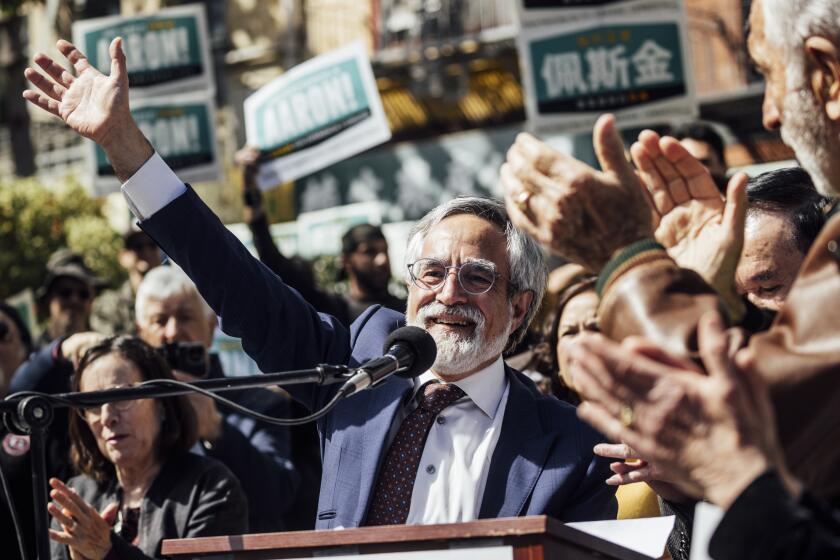Dynabook Sees Laptop Opening New Chapter in Computers
In the past eight years, former IBM and Tandon executive Dan H. Wilkie has become one of the industry’s best-known makers of computers for the desk. Now he’s making a computer for the lap.
Last week Wilkie, along with some of the Silicon Valley’s biggest investors, joined the highly competitive laptop computer market when they introduced a portable computer small enough to fit in a briefcase, yet with the power and memory of a desktop machine. A Westlake Village resident, Wilkie, 46, will be chief executive of the new company, Dynabook Technologies Corp., based in San Jose.
The introduction of the Dynabook machine is attracting a lot of attention in the computer business because some of high-technology’s best-known money men have put up $22 million to start the company. In addition, some computer experts believe the Dynabook machine advances the power and versatility of laptop computers, a $5-billion-a-year market that is one of the industry’s fastest-growing segments.
Founded in June, 1987, Dynabook’s main backer is the Palo Alto venture capital firm Kleiner Perkins Caufield & Byers and two of its partners, Vinod Khosla and John Doerr. Both men played key roles in starting and financing Sun Microsystems in Mountain View, one of the computer industry’s fastest-growing companies in the past five years.
Experienced Investors
Other prominent investors in Dynabook include the Wall Street firm Goldman Sachs & Co., the Silicon Valley investment firm Sequoia Capital and Mitch Kapor, who founded Lotus Development, the Boston-based software company best known for its Lotus 1-2-3 program. Investors have 85% of the company, with the company’s managers controlling 15%.
The role of Wilkie, who plans to keep his home in Westlake Village while working in San Jose, is to get the machine made and sold. He expects significant numbers of the machine to be available this summer.
In the early 1980s, Wilkie was a key member of the team of IBM executives who designed that company’s first personal computer, which set the standard for office personal computers.
In late 1985, Wilkie was recruited by Tandon founder Sirjang Lal (Jugi) Tandon to oversee the company’s transition from a maker of disk drive data storage devices to personal computers. Along with Wilkie, three other former IBM executives, H. L. Sparks, Joseph A. Sarubbi and William Sydnes, were recruited. All have left Tandon, and Sarubbi has joined Wilkie at Dynabook.
The hiring of the IBM executives got Tandon a lot of press. And, for a while, the company turned a solid profit selling computers, although mostly because sales in Europe were strong.
But Tandon, based in Moorpark, has yet to crack the domestic market, and its results lately have been dismal. In the year that ended Dec. 31, Tandon lost $19.9 million. In the first quarter ended that March 31, the company lost $9.9 million.
Left Tandon
Wilkie left Tandon in August, 1987, when the executive suite became too crowded. Jugi Tandon wanted to do more operational duties himself. In addition, a bigger role in the company was being taken by personal computer pioneer Chuck Peddle, one-time head of Victor Technologies who was Tandon’s executive vice president and chief operating officer. Peddle has since left Tandon, company executives said.
A short time later, Wilkie was approached by Khosla and Doerr, who asked him to help launch Dynabook.
The idea Khosla and Doerr had for a computer was inspired by the “Dynabook” concept developed in the late 1970s by Alan Kay, one of high-technology’s seminal thinkers who works for Apple Computer. The term is short for “Dynamic Book.” What Kay envisioned was a powerful computer that people would carry around, much like they carry around notebooks. Wilkie was given a starting budget and told to check whether new technological advances--such as portable computer screens that are easier to read and the development of smaller, 3 1/2-inch disk drive storage equipment--could be tied together to create a more powerful portable computer that would emulate Kay’s concept.
“Basically, they said: ‘Here’s an idea we have and $400,000. See if there is a market,’ ” Wilkie said.
Laptop computers typically are sold as adjuncts to desktop machines. Users buy one computer for the desk, and a separate portable one.
Dynabook’s machine, which weighs about 14 pounds with its screen attached and a battery installed, is designed to hook into a conventional screen in the office. When it is being used while traveling or at home, it is connected to a flat, removable screen.
The machine, which is expected to sell for more than $5,000 with a hard-disk storage device installed, was built so that it can be fitted with different screens, printers, power-supply units and computer pieces, much like the body of a camera can be fitted with different lenses.
It can accommodate hard disks of either 20 megabytes or 40 megabytes. A 40-megabyte drive is able to store up to 40 million characters.
Finis Conner, chief executive of Conner Peripherals, a San Jose company that is supplying disk drives for the Dynabook machine, said that the company’s obvious challenge is battling established portable computer companies such as Zenith, NEC and, most notably, Compaq Computer, which also makes a powerful laptop.
Stewart Alsop, editor of PC Letter, a Redwood City industry newsletter, calls the Dynabook computer a “really attractive machine in terms of performance.”
Alsop is most uncomfortable with Dynabook predictions that it will reach $100 million in sales in the first year of operation, because the industry is unpredictable and the laptop computer market is competitive.
“I don’t like people to make outrageous statements like that,” Alsop said. “If you do a good job, then you become a $100-million company. You don’t become a $100-million company by projecting it.”



